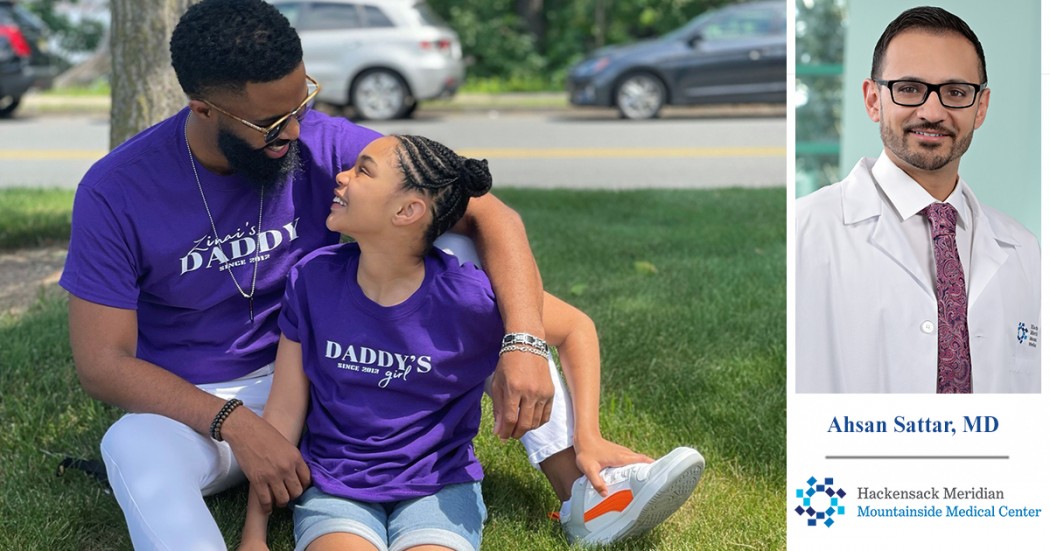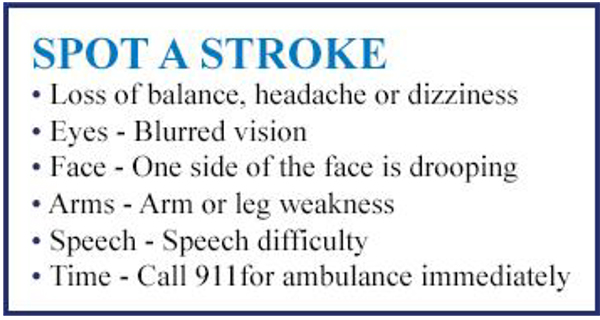Parent grateful for, inspired by Mountainside Medical Center’s stroke program

“It was a bright, sunny day in Caldwell (NJ) near the end of my daughter’s school year,” said Shaun Saunders. “I was on a conference call for work while I waited to pick her up. When I saw her walk out of school, I got out of my car, grabbed her hand, and escorted her to the back seat.”
After closing her door, Saunders walked around the car to drive home but stumbled and fell flat on the pavement. “For a moment I felt like I was walking up a steep hill and just lost my balance,” he said.
However, others nearby, including the school’s principal and teachers, knew they were witnessing a medical emergency. They immediately dialed 911 and got Saunders’ daughter out of the car while they waited for the ambulance.
 Minutes later, Saunders was on his way to Hackensack Meridian Mountainside Medical Center while paramedics treated him for a suspected stroke.
Minutes later, Saunders was on his way to Hackensack Meridian Mountainside Medical Center while paramedics treated him for a suspected stroke.
Stroke is the fifth leading cause of death and a leading cause of disability in the U.S. A stroke occurs when a blood vessel that carries oxygen and nutrients to the brain is either blocked by a clot or bursts.
When that happens, part of the brain cannot get the blood and oxygen it needs, which can kill brain cells. Early stroke detection and treatment are key to improving survival, minimizing disability, and accelerating recovery times.
This was Saunders’s second stroke. The first occurred in June 2020 amid the pandemic. “This recent stroke was much worse than the earlier one and had more severe symptoms,” he said.
At Mountainside Medical Center, Saunders was treated by Reza Karimi, MD an endovascular and vascular neurosurgeon, and Ahsan Sattar, MD, an endovascular interventional neurologist who specializes in cerebrovascular disease treatment and prevention. Dr. Sattar is the medical director for Mountainside Medical Center’s neuroendovascular program.
“After the first stroke, many doctors at another hospital thought I was a miracle survivor because I was so young,” recalled Saunders. “Unfortunately, nobody was diagnosing the problem.”
At Mountainside Medical Center, the doctors reviewed the medical notes from both strokes and determined that each originated from Saunders’ right side. They then determined that inserting a stent in one of Saunders’ arteries would increase blood flow and reduce the likelihood of an additional stroke.
“If Dr. Sattar had not reviewed the details of both strokes, I could have had another one,” said Saunders. “Fortunately for me and my family, he diagnosed the problem and saved my life.”
 Extensive rehabilitation efforts
Extensive rehabilitation efforts
After the surgery to implant the stent in his artery, Saunders began the long road to recovery that involved relearning many of the basic skills that are often taken for granted.
“Recovering from my first stroke was easier because the symptoms were less severe,” said the 38-year-old. “This time, my recovery was much harder and longer.”
Saunders worked with a speech therapist for more than a year to overcome stuttering. His mental acuity was often diminished, so he had to learn how to focus and read again. Since the stroke originated on his right side, his right hand didn’t function well. He had to relearn how to tie his shoes, type on a computer and even dress himself.
“For a long time, I relied on my family and friends to get through the day,” he recalled.
Through it all, Saunders said the treatments and support he received from providers and team members at Mountainside Medical Center were exemplary.
“I felt like a VIP, like Beyoncé or President Barack Obama,” Saunders admitted. “My family was so scared during this time, but everyone cared for us like we were part of their own family. I know that one can learn customer service through training, but what I experienced at Mountainside Medical Center was more like being part of their family.”
Moving forward
In his roles as a preacher, professor, writer, and worship leader, Saunders said his caregivers’ passion for their work has inspired his own work.
“I saw firsthand how they would go the extra mile to heal me and make me whole again,” he said. “This has inspired me to go the extra mile for my daughter, students, congregation, and other authors.”
After regaining the ability to read and write, Saunders was motivated to write about the hard times he faced so that, perhaps, others would be inspired to go “the extra mile” to confront their own difficulties.
His new book “Win Anyway – How to turn obstacles into opportunities,” was written to help readers face and overcome obstacles they experience in their own lives, as Saunders had to face the devastating effects of his stroke.
“These strokes have helped me to be a bit more human by giving myself and other people more grace,” he said. “I am able to do what I do because the medical team at Mountainside Medical Center poured so much love and care into me. Now I want to pour it into others.”
The care that Saunders and other stroke patients have received at Mountainside Medical Center has been nationally recognized.
The hospital has received the American Heart Association’s Target: StrokeSM Elite award. To qualify for this recognition, hospitals must meet specific criteria that reduce the time between an eligible patient’s arrival at the hospital and treatment with the clot-buster alteplase. In addition, Mountainside Medical Center is one of the few community hospitals capable of providing lifesaving thrombectomy procedures for patients experiencing stroke and has earned Thrombectomy-Capable Certification from the Joint Commission.
For more information regarding stroke services, visit the webpage for our Neuroscience Institute at Hackensack Meridian Mountainside Medical Center.




